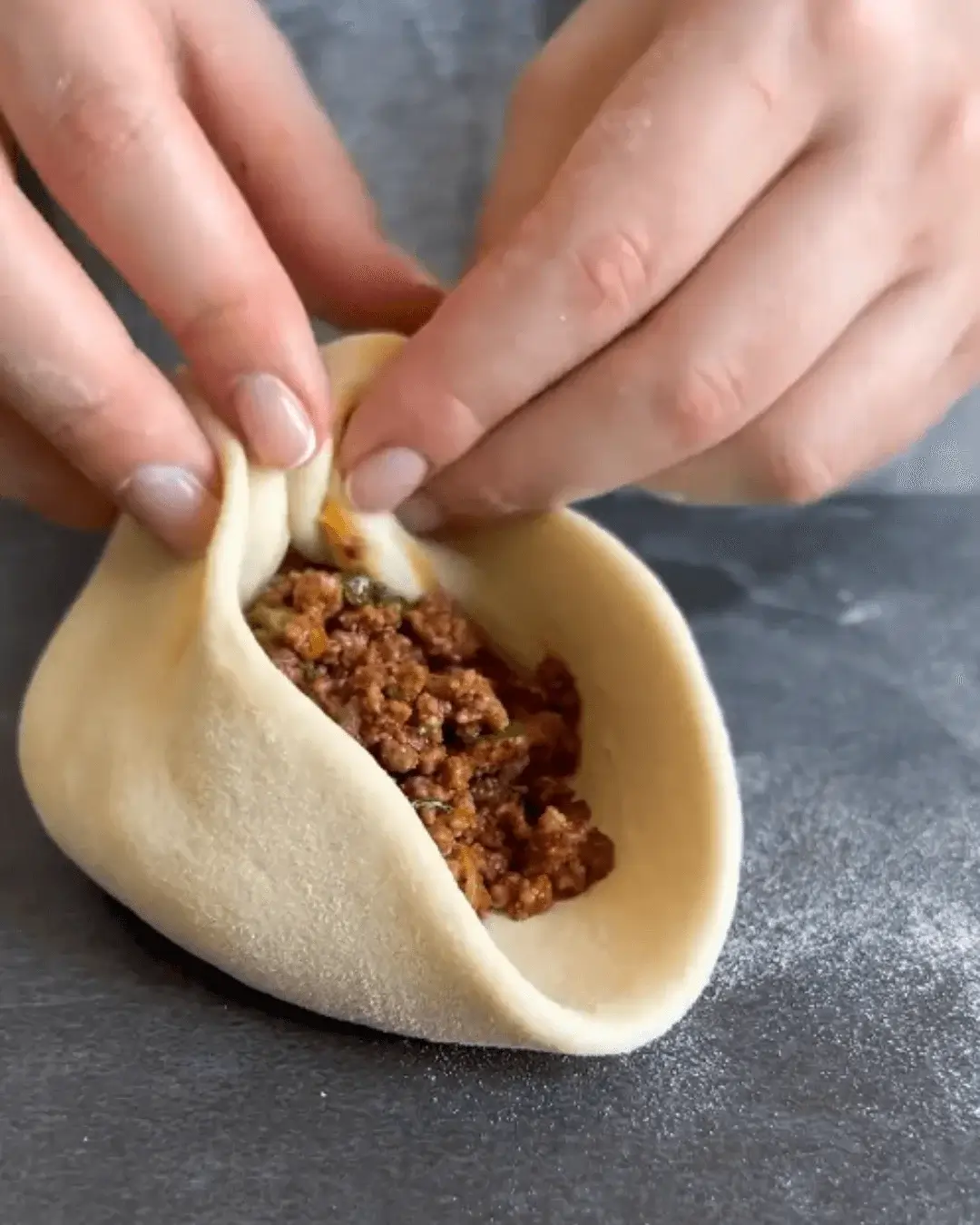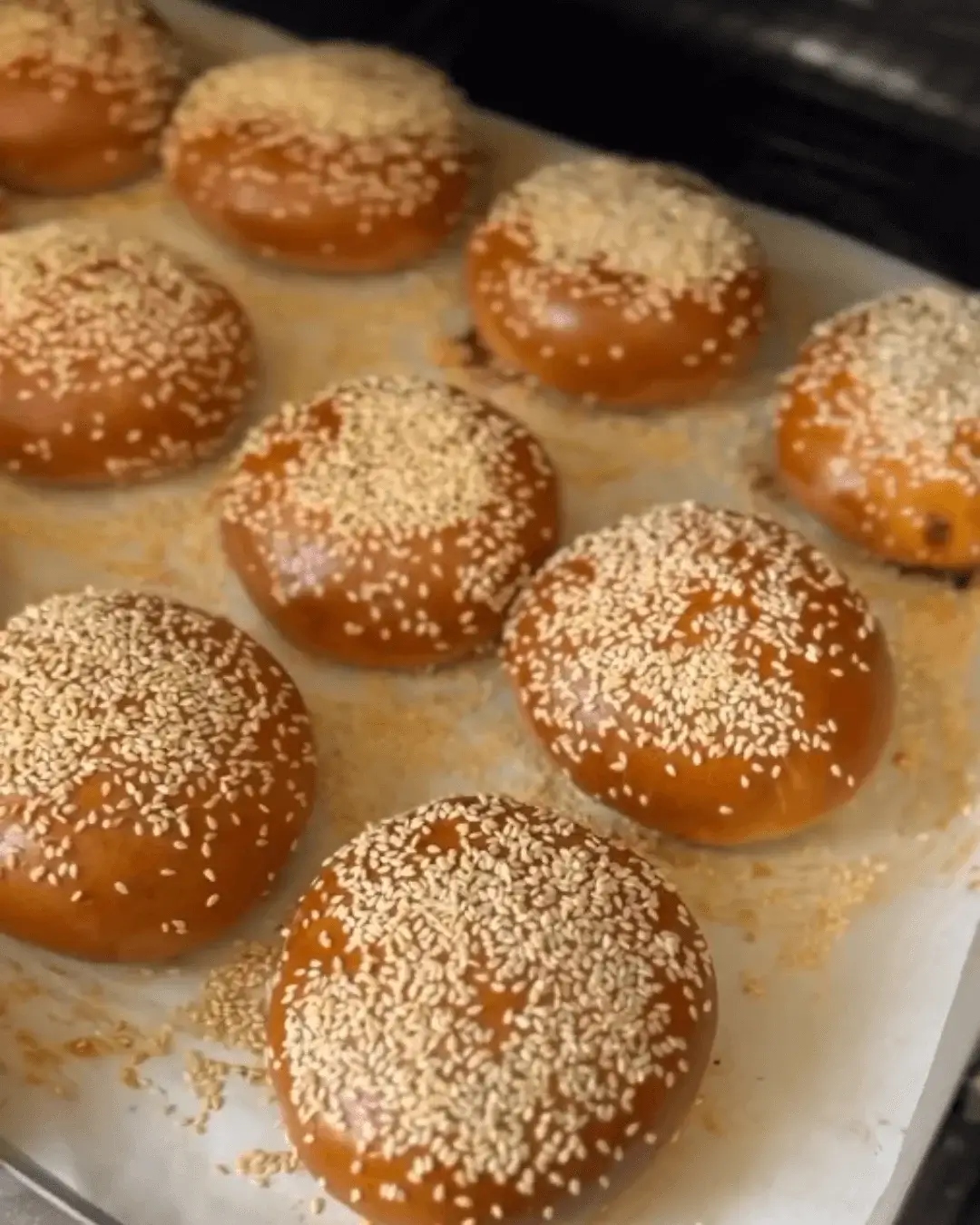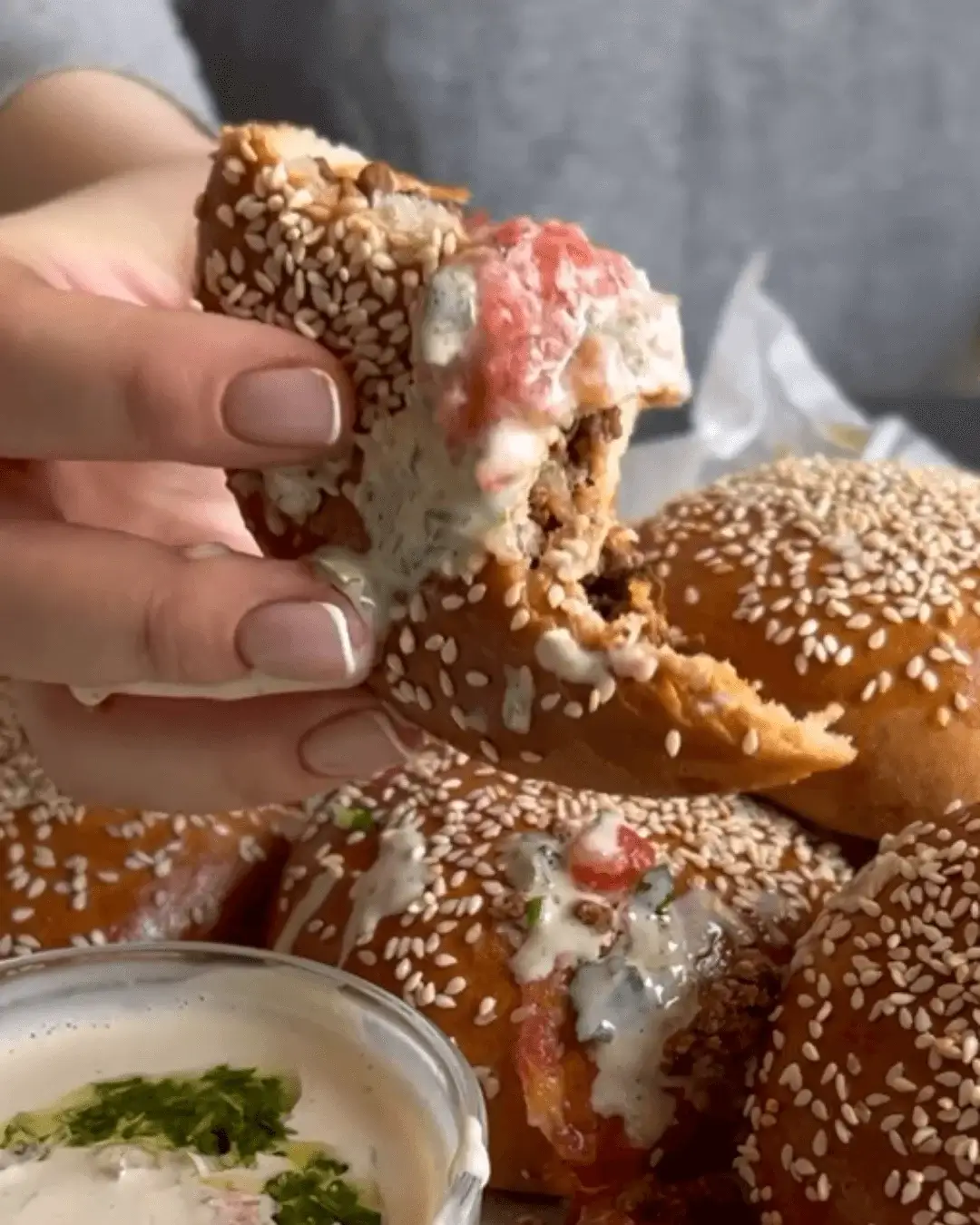Super Juicy Beef Bun Recipe You Will Not Stop Making
We may earn a commission from recommended products, at no extra cost to you. See Disclosure.
INGREDIENTS
Dough (20 buns):
Filling:
- 2 white onions, chopped
- 2.2 pounds/1 kilogram ground beef
- 3 garlic cloves, finely chopped
- ¼ teaspoon baharat
- ¼ teaspoon ras el hanout
- 1 tablespoon hot or sweet paprika
- Pinch of cumin
- Pinch of black pepper
- 1 tablespoon salt
- 3 heaping tablespoons tomato paste
- Handful of parsley, chopped
Toppings:
INSTRUCTIONS
Dough:
- In a mixer bowl, place flour, yeast, and sugar. Attach a kneading hook and start mixing on low speed. Add the oil and water in a thin stream. Continue mixing and add the salt. Knead the dough for at least 10 minutes on medium-low speed.
- Transfer the dough to a greased bowl, cover, and let it rise at room temperature until it doubles in size.
Filling:
- Preheat the oven to 350°F (180°C) with convection. Heat oil in a wide pot and sauté the onions until golden. Add the ground meat and garlic, breaking up the meat. Fry and add the spices and tomato paste. Mix well and remove from heat. Add the parsley and mix. Do not dry out the meat. Set the meat aside to cool completely.
Assembly:
- Turn the risen dough onto a work surface and divide it into balls, each weighing about 3 ounces (80-90 grams). Roll the balls and place them on baking paper or a greased surface, cover to prevent drying, and let them rest for 20 minutes.
- Take each ball and roll it out (you can lightly flour the work surface). Place 2 tablespoons of meat filling in the center. Close tightly and remove any excess. Repeat with all the balls, placing them on a baking tray lined with baking paper, and let them rise for about 20 minutes.
- Brush with egg, sprinkle with sesame seeds, and bake in the preheated oven at 350°F (180°C) with convection for about 25 minutes or until fully golden.
- Remove from the oven, brush with a bit of olive oil, let cool slightly, and eat.
- It is recommended to serve with tahini, tomato paste, some greens, and optionally schug (spicy Yemenite sauce).

FAQ
Can I use whole wheat flour for this beef bun recipe?
Yes, you can use whole wheat flour instead of all-purpose flour for this beef bun recipe, but the texture and taste will differ. Whole wheat flour makes the dough denser and gives it a nuttier flavor. You may need to add a bit more water since whole wheat flour absorbs more liquid. Also, expect the dough to rise less and take longer to knead. Mixing whole wheat flour with all-purpose flour can help balance the texture and flavor.

What is the best way to store leftover beef buns?
To store leftover beef buns, first let them cool completely. Place them in an airtight container or wrap them individually in plastic wrap or aluminum foil to prevent drying out. Store them in the refrigerator for up to 3-4 days. For longer storage, freeze the buns in a single layer on a baking sheet, then transfer them to a freezer-safe bag or container. To reheat, thaw in the refrigerator if frozen, and warm in an oven or microwave.

Can I freeze the beef buns before baking them?
Yes, you can freeze the beef buns before baking them. After assembling the buns, place them on a baking sheet lined with parchment paper and freeze until solid. Once frozen, transfer the buns to a freezer-safe bag or container. When ready to bake, let them thaw in the refrigerator overnight or at room temperature for a few hours. Allow them to rise for about 20 minutes before baking. Bake as directed, adding a few extra minutes if needed.

Can I substitute the beef with another type of meat?
You can substitute ground beef with other types of meat, such as ground turkey, chicken, lamb, or pork. Each meat will impart a different flavor and texture to the buns. Ground turkey and chicken are leaner options, so you might need to add a bit of oil or fat to keep the filling moist. Ground lamb or pork can add a richer taste. Adjust the seasoning and cooking time accordingly to ensure the meat is fully cooked and flavorful.

What can I use instead of baharat and ras el hanout?
If you don’t have baharat or ras el hanout to make this beef bun recipe, you can substitute with other spice blends or individual spices to make this beef bun recipe. For baharat, try using a mix of allspice, black pepper, cinnamon, and paprika. For ras el hanout, a combination of cumin, coriander, ginger, turmeric, and a pinch of cayenne pepper works well. Garam masala can also be a good alternative for either spice blend, adding a warm and complex flavor to your meat filling. Adjust quantities to taste.

How can I tell if the dough has risen enough?
To tell if the dough has risen enough, look for these signs: it should have doubled in size and feel light and puffy. Gently press your finger into the dough; if the indentation remains and doesn’t spring back, the dough is ready. Another test is to gently lift the dough from the bowl; it should stretch slightly without tearing. If the dough hasn’t risen enough, let it rest for a bit longer until it shows these signs.

Can I make the dough by hand if I don’t have a mixer?
You can make the dough by hand if you don’t have a mixer. Combine the flour, yeast, and sugar in a large bowl, then add the oil and water. Mix with a wooden spoon until a rough dough forms. Knead the dough on a floured surface for about 10-15 minutes until it becomes smooth and elastic. Be prepared for a bit more effort, but the dough will still rise and yield delicious meat buns.

What other toppings can I use in this beef bun recipe?
If you prefer to skip sesame seeds in this beef bun recipe, there are several tasty alternatives for topping your beef buns. You can use poppy seeds for a subtle crunch or dried herbs like oregano or thyme for added flavor. For a savory touch, try shredded cheese, like cheddar or Parmesan. Sea salt or garlic powder can also enhance the flavor. For a sweet option, brush with honey or sprinkle with cinnamon and sugar for a unique twist.


Prevent the buns from drying out during the second rise
To prevent the buns from drying out during the second rise, cover them with a clean, damp kitchen towel or plastic wrap. Make sure the cover is not touching the dough to avoid sticking. You can also lightly oil the surface of the dough before covering to retain moisture. Keep the buns in a warm, draft-free area. If the environment is too dry, placing the tray in a slightly closed oven with a pan of hot water can help.

Can I add vegetables to the filling?
Yes, you can add vegetables to the meat filling for extra flavor and nutrition. Finely chopped vegetables like bell peppers, carrots, or mushrooms can be sautéed with the onions before adding to the meat. Adding spinach or kale is another great option. Make sure to cook and drain the vegetables well to avoid excess moisture, which can make the filling soggy. Adjust the seasoning to complement the vegetables and ensure a well-balanced, flavorful filling.

How do I know when the buns are fully baked?
To know when the buns are fully baked, look for a golden-brown color on top. Gently tap the bottom of a bun; it should sound hollow if baked through. You can also use a food thermometer; the internal temperature should be about 190°F (88°C). If the tops brown too quickly, cover with foil and continue baking until done. Ensure the buns have a firm texture but are not overcooked. Let them cool slightly before serving.

What should I do if the dough is too sticky to handle?
If the dough is too sticky to handle, you can fix it by lightly flouring your work surface and hands. Sprinkle a small amount of flour onto the dough and gently knead it in. If it remains sticky, gradually add more flour, a little at a time, until the dough becomes manageable. Be careful not to add too much flour, as it can make the dough dry. Alternatively, you can also chill the dough briefly to make it easier to work with.

Is it possible to make this beef bun recipe gluten free?
Yes, it’s possible to make this beef bun recipe gluten free by using a gluten free flour blend instead of all-purpose flour. Look for a blend that includes xanthan gum or guar gum, which helps mimic gluten’s elasticity and structure. You may need to adjust the amount of water, as gluten free flours can absorb liquids differently. For the meat filling, check that all spices and ingredients are gluten-free. After preparing the dough, allow it to rise in a warm, draft-free area. Gluten free dough may not rise as much as regular dough, so expect a denser texture but still delicious results.

